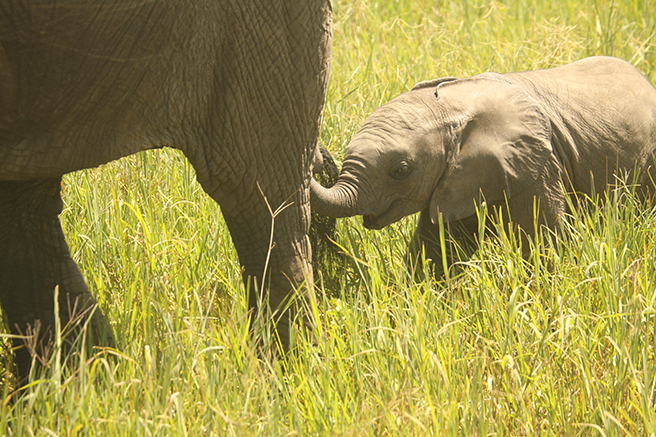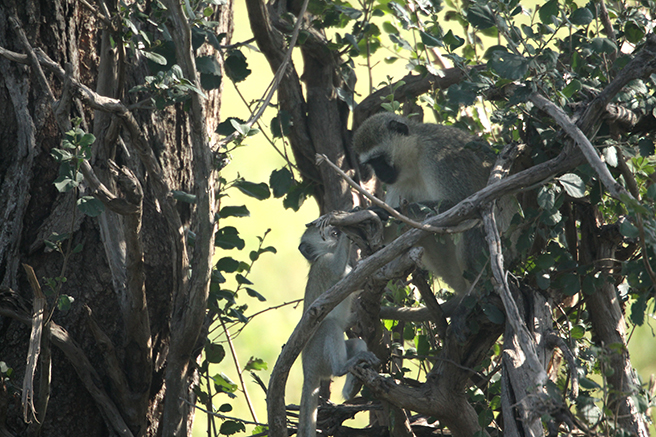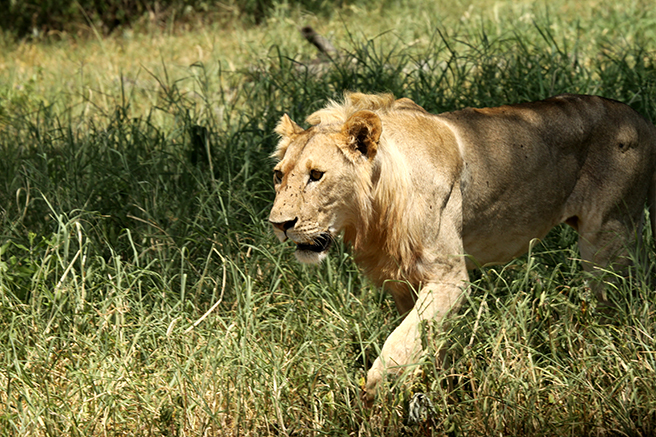Elephants Galore

Day 3 was our first all-day drive, and I loved it. If it were up to me, we would have done all-day drives every day. Of course, if it were up to me we’d also still be in Africa and the safari would never end. If I’d thought Day 2 brought a lot of elephants, Day 3 was the Powerball jackpot of elephants.
It seemed as if every five minutes we saw more of them. At one point late in the afternoon I asked Hashim how many elephants live in the park, and he said about 5,000. I joked that I felt as if we’d seen at least half, then laughed and said I knew I was exaggerating but I was sure we’d seen hundreds. But then, at dinner that night, Stephen said we’d seen about half the elephants in the park over our two-and-a-half days there, so I guess my joking guesstimation was more spot-on than I realized.
We saw our tiniest baby of the trip on Day 3. I swear he (or she) had just figured out that he had a trunk. Just like a human baby playing with the feet he’s just discovered, the baby elephant was playing with his trunk, coiling and twisting it nonstop into all kinds of configurations as if just discovering what it could do. We also drove up on one herd that had staked out the middle of the road and had no intention of moving, so we finally had to four-wheel it up onto the verge to circle around them. At another point we were watching a herd made up of the usual mix of females with young adults of both sexes all the way down to babies, and let me tell you, some of those females are huge. The bulls are solitary and travel around looking for interested females, and while we were watching a bull came up behind the herd to check out the social scene. Suddenly those females looked small.
And then there was the big bull who stood in the road blocking our passage and staring at us. We were all standing and looking out the pop-top when he decided to angle past us. Stephen quickly shushed us, and we pretty much held our breath as he walked by, giving us a good long look as he went. I’m not exaggerating when I say that if I’d been a fool, I could have reached out and touched him as he passed.

The day was filled with much more than elephants, though thinking about all the elephants we saw, I’m not sure how we managed to see so many other species. A few highlights, including some species we hadn’t seen before: a leopard tortoise, ostriches, hartebeest, vervet monkeys – including babies – impala, squirrels (I have a thing for squirrels, so this was a highlight for me), Grant’s gazelle, reedbuck and waterbuck, wildebeest, a fish eagle, a mud-wallowing warthog, lots of giraffe, dwarf mongoose, a swimming monitor lizard, egrets, the truly-superb superb startling, red-billed ibis, saddle-billed storks, a hamerkop in flight, the lilac-breasted roller, the Kori bustard (the largest bustard) and helmeted guinea fowl.
We also saw Cape buffalo, which are just plain huge. Not as huge as elephants, but so solid and perennially grumpy looking that they look much more intimidating. And that sighting took us to four of the big five. I hadn’t realized that the so-called “big five” are a hunting thing, so until someone explained that to me, I couldn’t figure out why giraffes, so quintessentially African, weren’t included. But the big five are considered the biggies because they’re the most dangerous species to hunt. They include the lion, leopard, elephant, buffalo and rhino. And since there aren’t any rhino in Tarangire, seeing the four “available” species in just a few days was a pretty impressive accomplishment, especially considering the scarcity of lions in the center of the park at that point. And speaking of lions…

We saw a group of four young lions, probably littermates, that day. There were three females and one male, who was just developing a very blond mane. That was one way to tell they were young; another was that they still had baby spots on their bellies. They were all thin, but with glossy coats, so they were overall in good shape, and one of the females was much lighter than the others, almost the pale gold of a cougar. They started out lounging under a tree, then got up and walked along parallel to the road, so close that I couldn’t avoid getting the shadow of the Rover in some of my shots. Later we also saw a fully-maned male – sleeping, of course, since that seems to be the males’ favorite activity – with a female and a cub. A reedbuck was watching them from a riverbank a hundred or so feet away. He clearly wanted to go in their direction but was wary of passing so close to anyone who might be interested in eating him.
This was our last full day in Tarangire, and as a way for the park to demonstrate its riches, it was a winner. Everyone hears “Tanzania” and thinks “Serengeti,” and I won’t kid you: the Serengeti was amazing. But I’d never even heard of Tarangire until I won this trip, and now I can’t imagine going back to Tanzania without building in time to revisit Tarangire and further explore its amazing wealth of animal life.